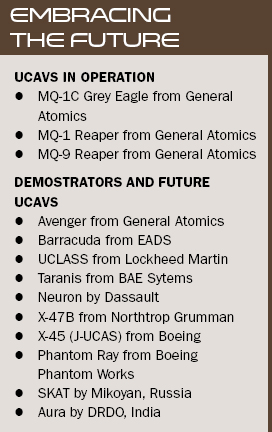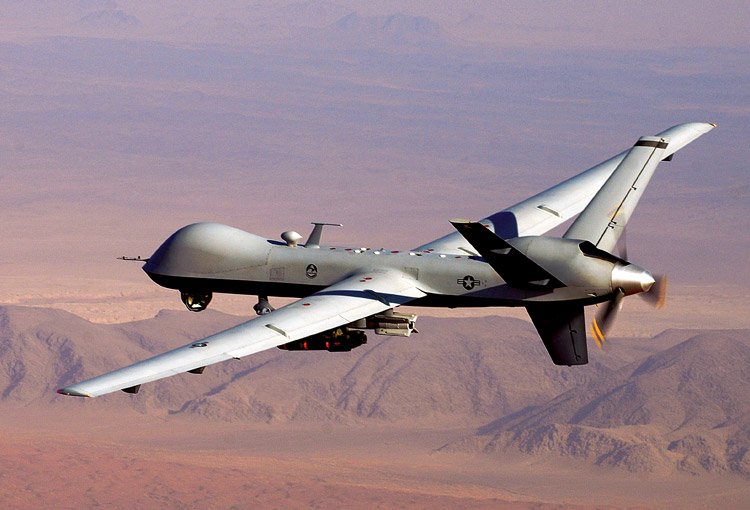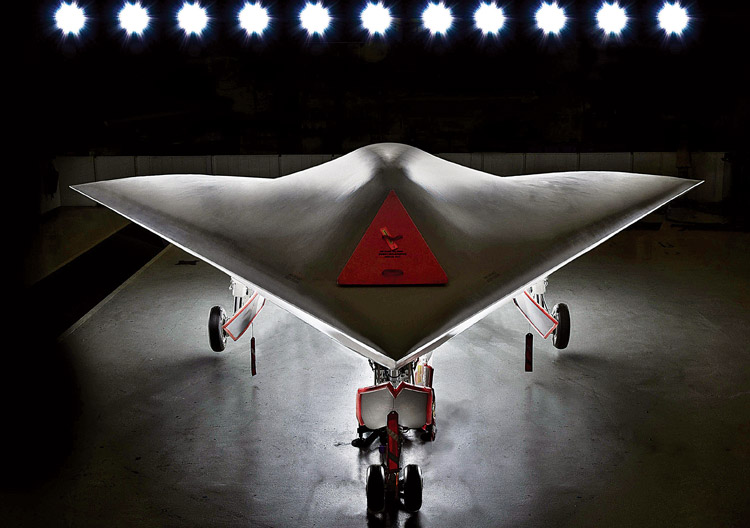INDIAN ARMED FORCES CHIEFS ON
OUR RELENTLESS AND FOCUSED PUBLISHING EFFORTS

SP Guide Publications puts forth a well compiled articulation of issues, pursuits and accomplishments of the Indian Army, over the years

I am confident that SP Guide Publications would continue to inform, inspire and influence.

My compliments to SP Guide Publications for informative and credible reportage on contemporary aerospace issues over the past six decades.
UCAVs in Combat
While the concept of unmanned aerial systems in combat has come a long way, there is room for further innovation to enhance operational capabilities, lethality and survivability of UCAVs

It was during World War II that the Germans truly demonstrated for the first time ever the concept of the employment of a remotely piloted aerial platform as a weapon to attack and destroy a vital target on the ground. Called the FX1400 and also known by the name Fritz X, this aerial platform was actually a radio controlled bomb weighing 2, 300 kg with design features that made it capable of gliding like a fixed-wing flying machine. Also referred to as the “Glide Bomb”, the FX1400 was designed by the Germans to be released from a bomber aircraft of the Luftwaffe that would be operating at an altitude so as to be well outside the range of the anti-aircraft guns of the Allied forces firing from the ground or from ships at sea.
After release from the bomber aircraft, the FX1400 would enter its glide path and be steered to the intended target by the operator by means of a radio link, from onboard the mother aircraft. It was necessary for the operator onboard the mother aircraft to remain in visual contact with both the glide bomb and the target which would generally be a cruiser or a battle-ship at sea. With the help of the radio link, the operator could exercise the facility to alter the glide path of the FX1400 in the event the target was carrying out any evasive manoeuvres.
Unmanned Combat Aerial Vehicle (UCAV)
While the origins of the modern UCAV is said to lie in the German FX1400, the period after World War II witnessed practically no further development of this novel concept. After World War II, unmanned aerial vehicles (UAV) were used primarily as targets for training of personnel in firing of surface based artillery or machine guns fitted on fighter or bomber aircraft.

However, what really provided the impetus for the development of technology in the regime of UCAVs was the attack by terrorists on the World Trade Center on September 11, 2001. This not only led to the wars in Afghanistan and Iraq but also the global war on terrorism sponsored by the United States. The campaign against terrorism is still going on in the remote areas of Afghanistan and Pakistan. This has generated fresh demand for UCAVs armed with Hellfire missiles. This combination of unmanned aerial platform and weapon system was first tested on the Predator UCAV in February 2001. While the US military employs a wide variety of UCAVs, there are only three currently in use that have offensive capabilities. These are the MQ-1 Predator which the most commonly used, the MQ-1C Sky Warrior and the MQ-9 Reaper, all three built by General Atomics.
While the concept of unmanned aerial vehicles in combat has come a long way since it was first demonstrated by the Germans over seven decades ago, there is still room for further innovation to enhance the operational capabilities, lethality and survivability of UCAVs.
The Primary Components of UCAV
The primary components of a UCAV that need to be strengthened and upgraded are as under:
- Airframe of the structural component of the platform.
- Propulsion system.
- Payload, i.e. the weapon load that the platform can carry.
- Integral power supply.
- Data link.

Airframe Design
Perhaps the most important aspect of the design of the airframe of the UCAV of the future will be that it must incorporate advanced stealth features. Such design concepts pertaining to stealth have been successfully adopted for all the fifth-generation combat aircraft. Apart from the stealthy design of the airframe structure itself, the surface of the airframe must have a coating of materials such as Biopolymer and Isomers. These are self-healing materials, a coating of which will increase the absorption of radio energy and hence reduce the reflection of radar waves of the enemy. These features will provide the UCAV of the future with relatively greater immunity to detection by enemy radar and hence far less vulnerable. Also, coating of the airframe with these specialised self-healing materials will reduce airframe drag substantially which in turn help reduce fuel consumption and enhance both the range and endurance of the platform.

Propulsion System
Propulsion technology is a factor that is critical to the performance of an UCAV. As UCAVs of the current generation are much smaller in size when compared with fixed-wing combat aircraft, the focus of designers of UCAVs has invariably been on technology related to engines of relatively smaller size. However, as the UCAV is being seen as a partial if not an absolute replacement of fixed-wing combat aircraft, UCAVs of the future are expected to be larger in size and consequently heavier, for the carriage of larger weapon loads. Not only will the propulsion systems of the UCAVs of the future will have to be more powerful with higher thrust-to-weight ratio, they would have to have much lower Specific Fuel Consumption (SFC), higher levels of reliability and significantly lower noise levels.
Payload Considerations
By virtue of the fact that UCAVs are much smaller in size as compared to fixed-wing combat aircraft, the immediate implication is that its payload capability emerges as a major limiting factor. The Predator can carry a maximum of eight Hellfire missiles or a combination of four missiles and two laser-guided bombs. For the UCAV to compete with fixed-wing combat aircraft in respect of capability to carry weapon load, it will need to carry far heavier payloads. This understandably constitutes a serious dilemma for agencies involved in the creation of designs of UCAVs. Any attempt to increase the payload capability would have immediate impact on range and endurance of the platform thus severely limiting its overall operational capability. As UCAVs must necessarily be smaller in size as compared with combat aircraft, its capability to carry weapon load is consequently somewhat limited. One possible solution for surmounting this limitation would be the miniaturisation of weapons that would be carried by the UCAV and the platform must be capable of very high precision in the delivery of the weapon against intended targets. However, miniaturisation of weapons must be carried out without in any way degrading their destructive potential or impinging on their capability of precision attack. This would require considerable research and innovation.
FOR THE UCAV TO COMPETE WITH FIXED-WING COMBAT AIRCRAFT IN RESPECT OF CAPABILITY TO CARRY WEAPON LOAD, IT WILL NEED TO CARRY FAR HEAVIER PAYLOADS
Integral Power Suply
The variety of sensors onboard the UCAV are operated by power drawn from an onboard integral battery. Thus the duration for which the onboard battery can provide sustained power supply, automatically becomes a limiting factor for the length of time the UCAV can sustain its operational capability when airborne for a mission. This is a serious limitation that affects the operational potential of UCAVs that are powered by batteries of the current generation. This limitation can be overcome by radically new and different power sources that would be developed in the future. A possible next-generation power source could be a bio mass reactor that may become a reality by 2035.
Data Link
Quite unlike the German FX1400 for which the operator on board the mother aircraft needed line of sight contact with the glide bomb to steer it to the target by means of a radio link, UCAVs of the current generation are being operated from thousands of miles away through a satellite-based data link. Such operations by the US forces with UCAV operators located in the US, have been going on in the terrorist havens of Pakistan and Afghanistan for some time with notable success. However, data link is not only a critical component; but is vulnerable to a variety of threats as well. If degraded or compromised in any way, the consequences for operations by UCAVs could be disastrous. There is a need for uninterrupted communication with exchange of data between the UCAV and ground control. This will require improvement in bandwidth management with more efficient modulation methods, better network architecture and a highly secure data link. Network architectures including protocols and interfaces must be flexible enough to allow inter operability. Transfer of command between a ground station and a ship borne command and control system should the mission so require, should be instantaneous and without any interruption. The command and control links must be secure and robust enough to obviate the possibility of hijack of the UCAV as has happened in the past. In order to eliminate the possibility of interference or intrusion it would be necessary to use optimised frequency spectrum allocation and encrypted networks.
Conclusion
While UCAVs may not be able to totally replace the manned combat aircraft in the foreseeable future, its potential for employment as a combat platform in the battlefield of the future must not be underestimated. However, there would be a need for related technologies to evolve continuously to enable future unmanned systems to be able successfully combat the rapidly evolving challenges of the battlefield.





